Abstract
A survey was performed on the results of 138 carcinogenicity studies conducted in various mouse strains by the agrochemical industry over the period 1983-1993. Data for liver tumor incidence, liver weight, and histopathology were collected along with data on genotoxicity. Studies were judged positive or negative for liver tumor formation on the basis of apparent dose response, malignancy, and difference from historical control values using a weight of evidence approach. Thirty-seven studies were judged to be positive for liver tumorigenicity in one or both sexes. There was no evidence showing an influence of the mouse strain and the duration of the study on the proportion of positive studies. Although 8 of the chemicals tested in the 138 studies were positive in the Ames test, only one of these was judged positive for carcinogenicity. Only 6 of the 37 positive chemicals had any other reported positive genotoxicity findings. A clear relationship between hepatomegaly at 1 year after exposure and a positive tumorigenic outcome at 18 months or 2 years after exposure was demonstrated. Whereas the average relative liver weight of top dose animals was 110% of control in negative studies, it was 150% in positive studies. Likewise, very few negative studies demonstrated significant pathological findings after 1 year, whereas the majority of positive studies had significant liver pathology. The implications of these findings for extrapolation to humans are discussed.
Full text
PDF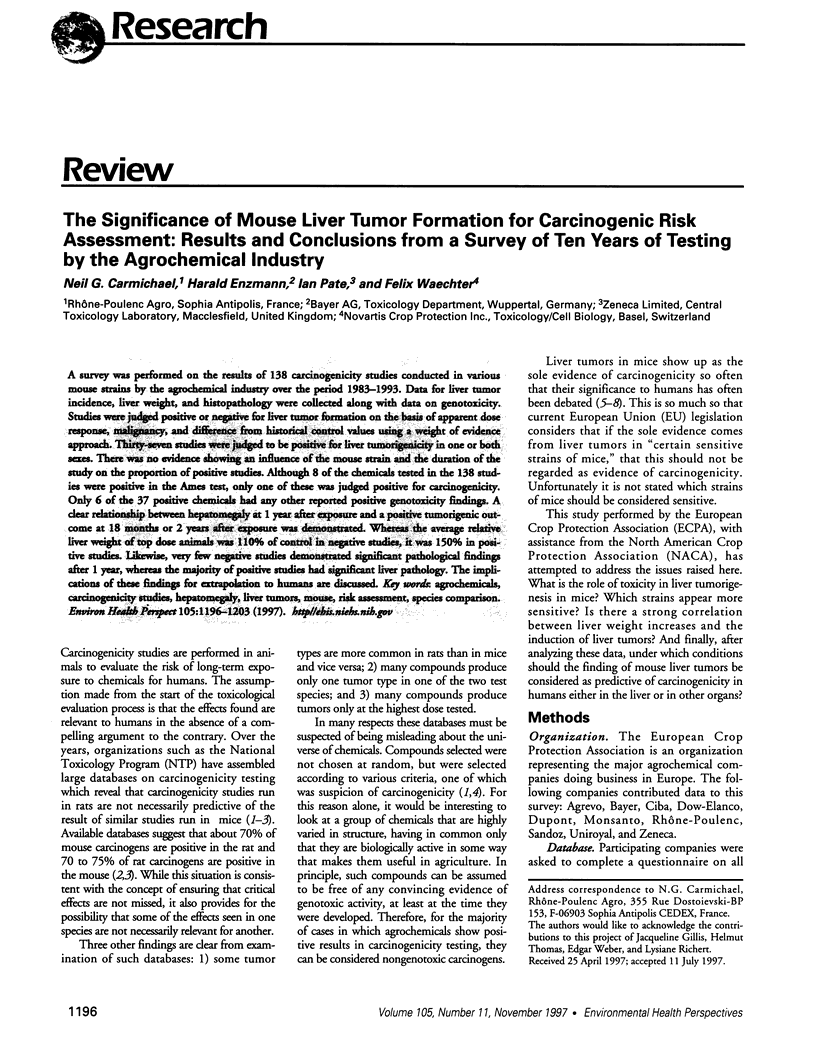
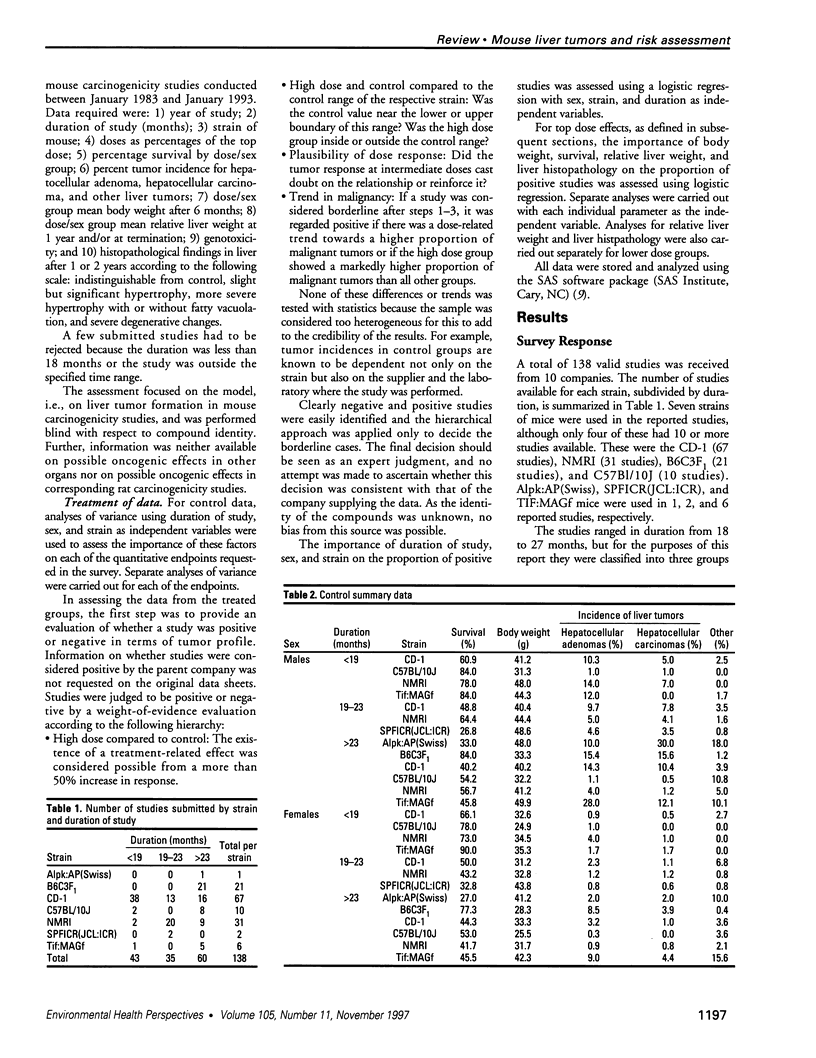
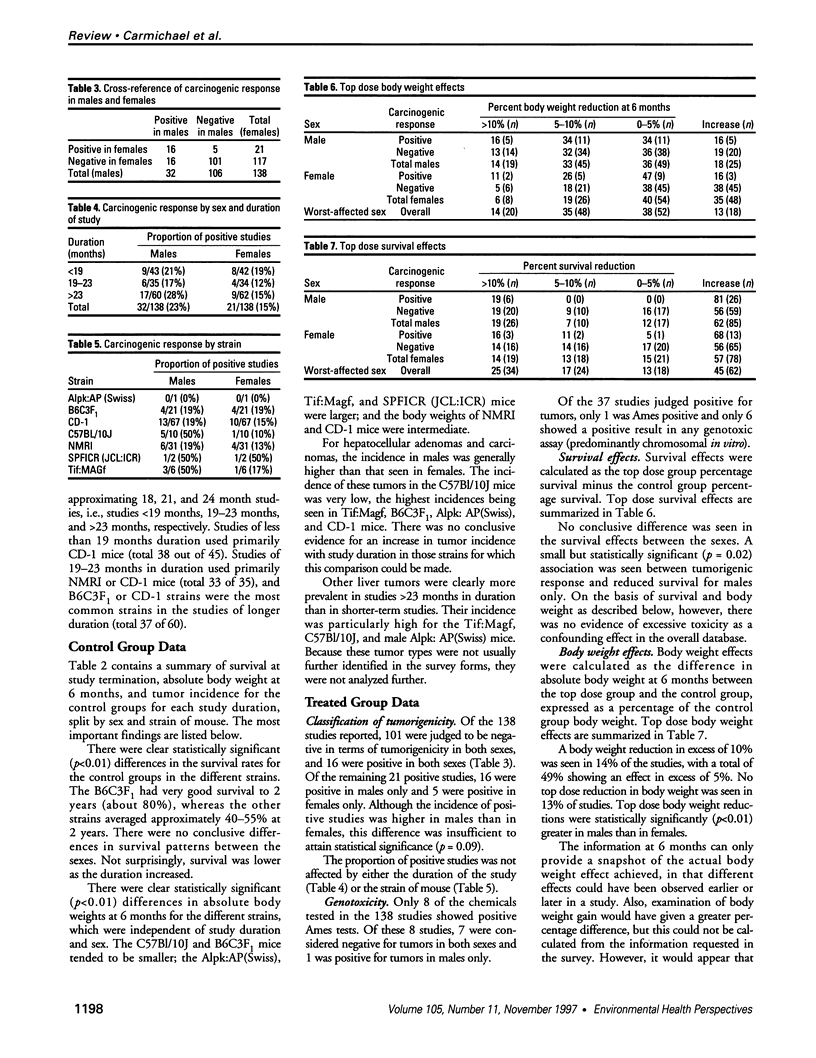
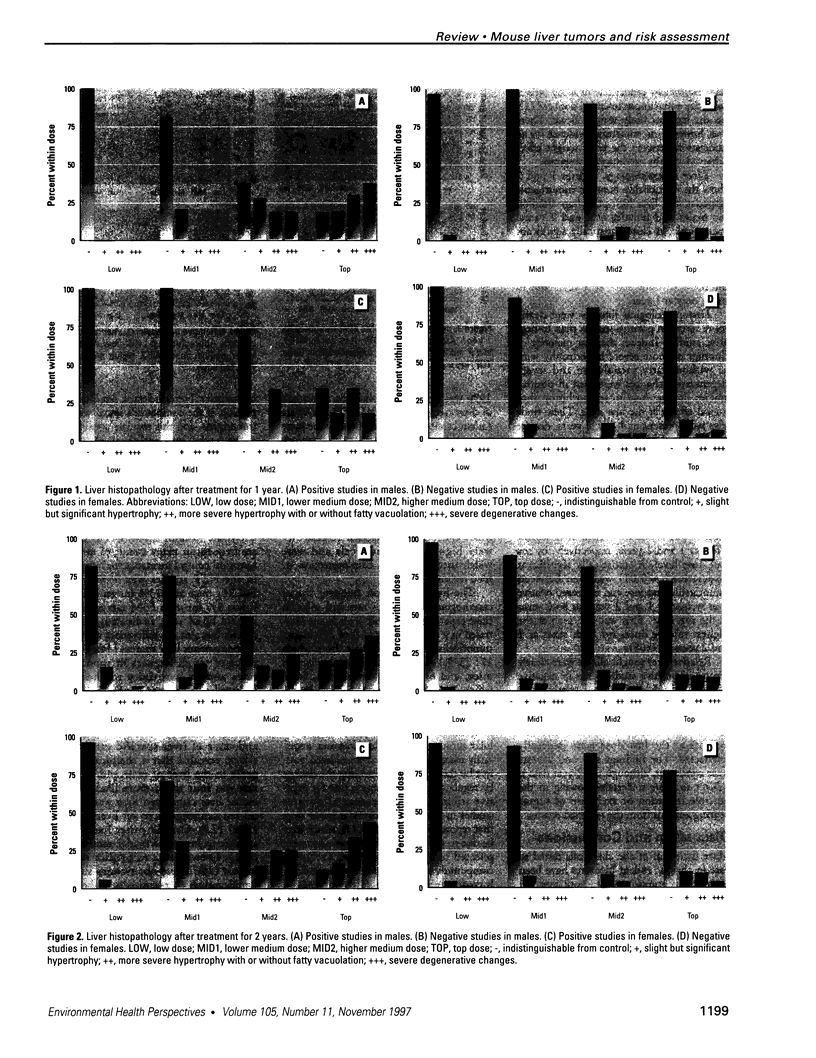
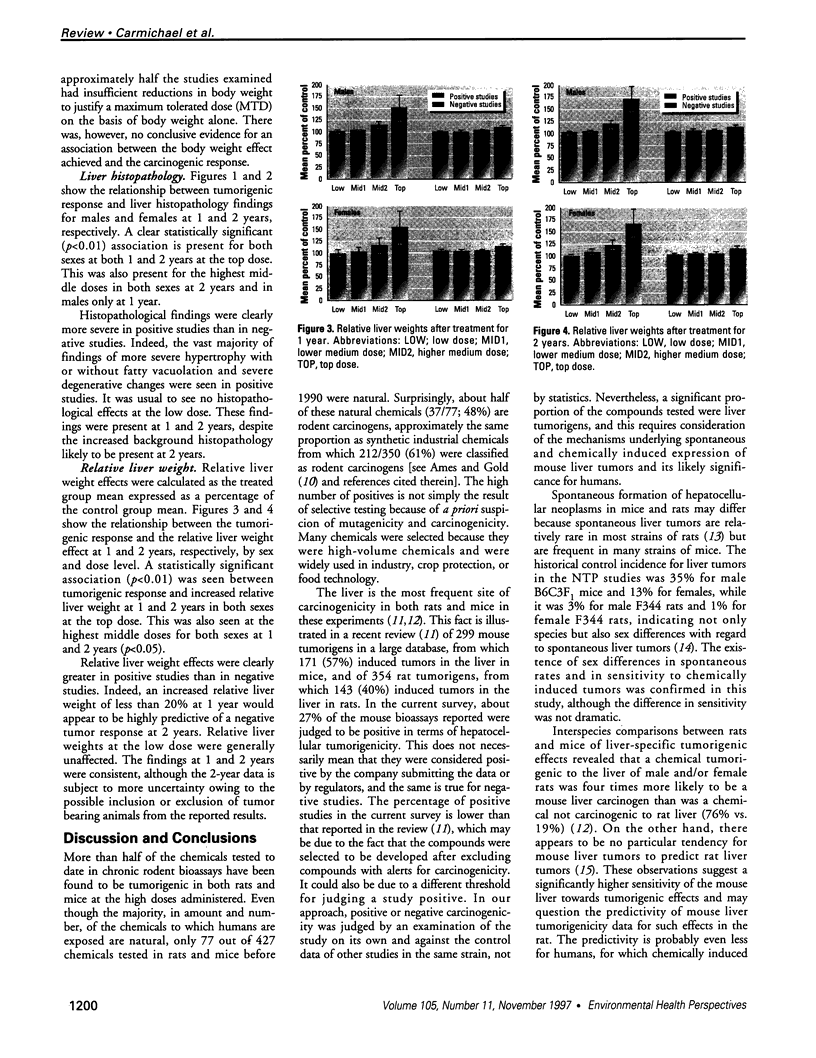
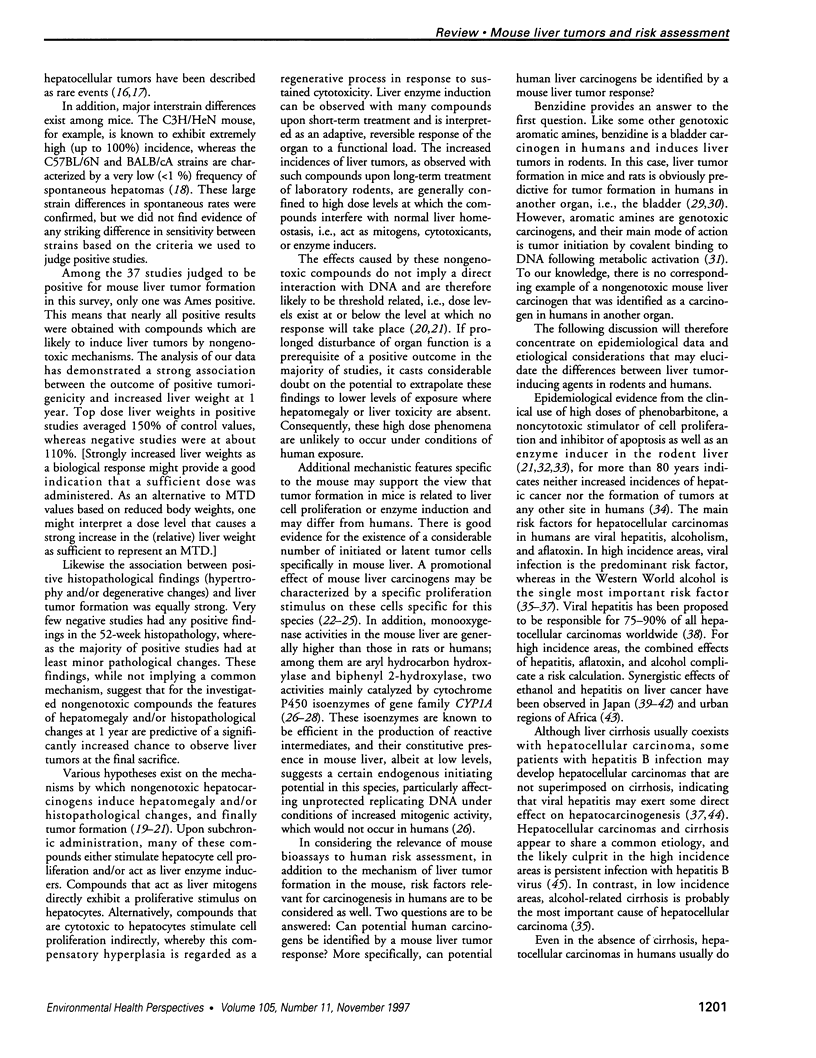
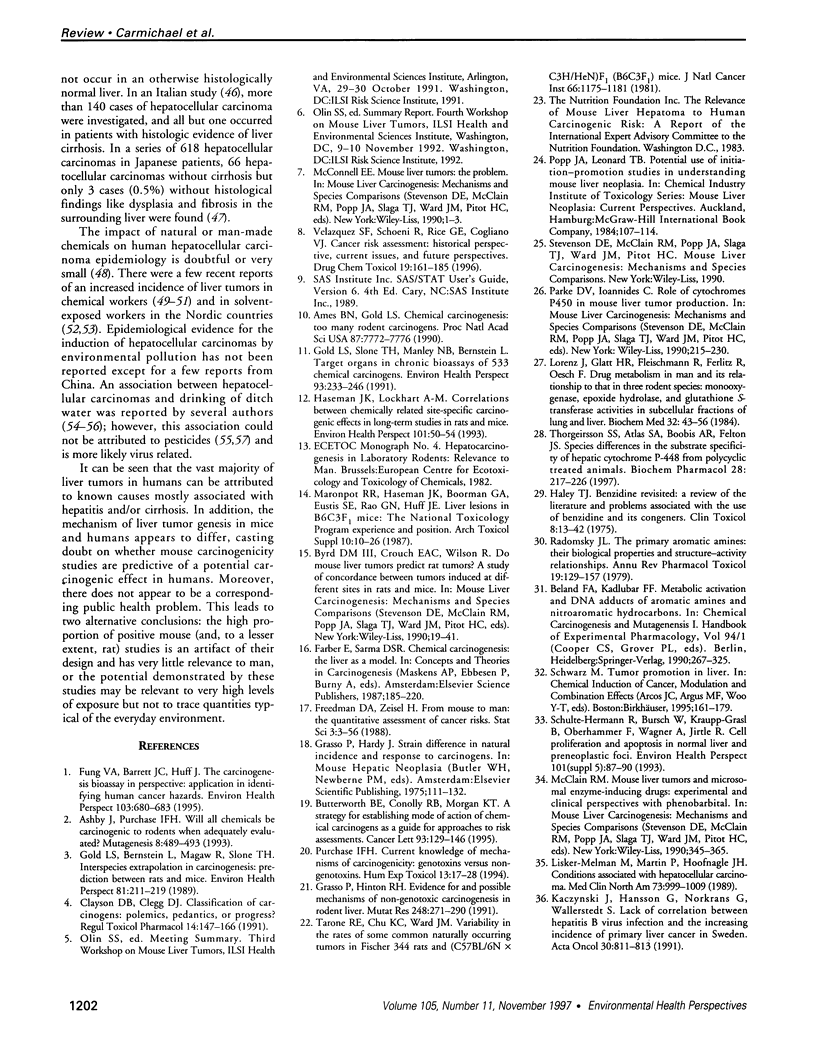
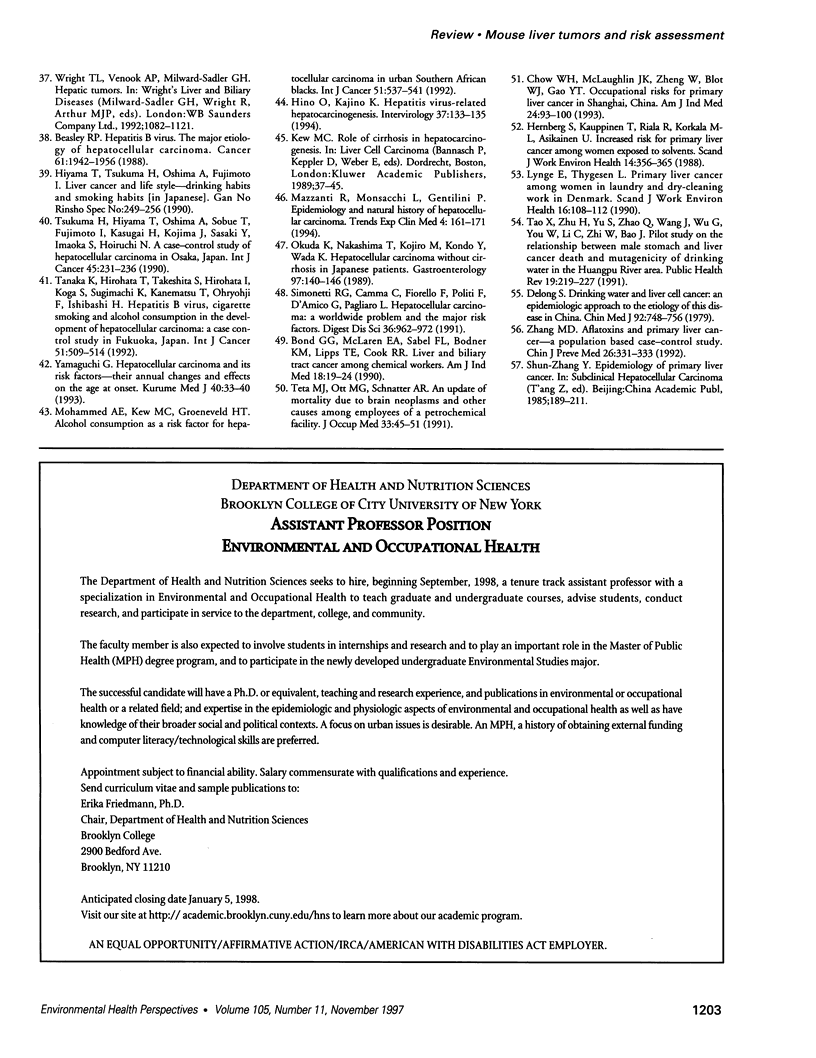
Images in this article
Selected References
These references are in PubMed. This may not be the complete list of references from this article.
- Ames B. N., Gold L. S. Chemical carcinogenesis: too many rodent carcinogens. Proc Natl Acad Sci U S A. 1990 Oct;87(19):7772–7776. doi: 10.1073/pnas.87.19.7772. [DOI] [PMC free article] [PubMed] [Google Scholar]
- Ashby J., Purchase I. F. Will all chemicals be carcinogenic to rodents when adequately evaluated? Mutagenesis. 1993 Nov;8(6):489–493. doi: 10.1093/mutage/8.6.489. [DOI] [PubMed] [Google Scholar]
- Beasley R. P. Hepatitis B virus. The major etiology of hepatocellular carcinoma. Cancer. 1988 May 15;61(10):1942–1956. doi: 10.1002/1097-0142(19880515)61:10<1942::aid-cncr2820611003>3.0.co;2-j. [DOI] [PubMed] [Google Scholar]
- Bond G. G., McLaren E. A., Sabel F. L., Bodner K. M., Lipps T. E., Cook R. R. Liver and biliary tract cancer among chemical workers. Am J Ind Med. 1990;18(1):19–24. doi: 10.1002/ajim.4700180103. [DOI] [PubMed] [Google Scholar]
- Butterworth B. E., Conolly R. B., Morgan K. T. A strategy for establishing mode of action of chemical carcinogens as a guide for approaches to risk assessments. Cancer Lett. 1995 Jun 29;93(1):129–146. doi: 10.1016/0304-3835(95)03794-W. [DOI] [PubMed] [Google Scholar]
- Chow W. H., McLaughlin J. K., Zheng W., Blot W. J., Gao Y. T. Occupational risks for primary liver cancer in Shanghai, China. Am J Ind Med. 1993 Jul;24(1):93–100. doi: 10.1002/ajim.4700240109. [DOI] [PubMed] [Google Scholar]
- Clayson D. B., Clegg D. J. Classification of carcinogens: polemics, pedantics, or progress? Regul Toxicol Pharmacol. 1991 Oct;14(2):147–166. doi: 10.1016/0273-2300(91)90003-e. [DOI] [PubMed] [Google Scholar]
- Fung V. A., Barrett J. C., Huff J. The carcinogenesis bioassay in perspective: application in identifying human cancer hazards. Environ Health Perspect. 1995 Jul-Aug;103(7-8):680–683. doi: 10.1289/ehp.95103680. [DOI] [PMC free article] [PubMed] [Google Scholar]
- Gold L. S., Bernstein L., Magaw R., Slone T. H. Interspecies extrapolation in carcinogenesis: prediction between rats and mice. Environ Health Perspect. 1989 May;81:211–219. doi: 10.1289/ehp.8981211. [DOI] [PMC free article] [PubMed] [Google Scholar]
- Gold L. S., Slone T. H., Manley N. B., Bernstein L. Target organs in chronic bioassays of 533 chemical carcinogens. Environ Health Perspect. 1991 Jun;93:233–246. doi: 10.1289/ehp.9193233. [DOI] [PMC free article] [PubMed] [Google Scholar]
- Grasso P., Hinton R. H. Evidence for and possible mechanisms of non-genotoxic carcinogenesis in rodent liver. Mutat Res. 1991 Jun;248(2):271–290. doi: 10.1016/0027-5107(91)90062-s. [DOI] [PubMed] [Google Scholar]
- Haley T. J. Benzidine revisited: a review of the literature and problems associated with the use of benzidine and its congeners. Clin Toxicol. 1975;8(1):13–42. doi: 10.3109/15563657508988044. [DOI] [PubMed] [Google Scholar]
- Haseman J. K., Lockhart A. M. Correlations between chemically related site-specific carcinogenic effects in long-term studies in rats and mice. Environ Health Perspect. 1993 Apr 22;101(1):50–54. doi: 10.1289/ehp.9310150. [DOI] [PMC free article] [PubMed] [Google Scholar]
- Hernberg S., Kauppinen T., Riala R., Korkala M. L., Asikainen U. Increased risk for primary liver cancer among women exposed to solvents. Scand J Work Environ Health. 1988 Dec;14(6):356–365. doi: 10.5271/sjweh.1907. [DOI] [PubMed] [Google Scholar]
- Hino O., Kajino K. Hepatitis virus-related hepatocarcinogenesis. Intervirology. 1994;37(2):133–135. doi: 10.1159/000150368. [DOI] [PubMed] [Google Scholar]
- Hiyama T., Tsukuma H., Oshima A., Fujimoto I. [Liver cancer and life style--drinking habits and smoking habits]. Gan No Rinsho. 1990 Feb;Spec No:249–256. [PubMed] [Google Scholar]
- Kaczynski J., Hansson G., Norkrans G., Wallerstedt S. Lack of correlation between hepatitis B virus infection and the increasing incidence of primary liver cancer in Sweden. Acta Oncol. 1991;30(7):811–813. doi: 10.3109/02841869109091826. [DOI] [PubMed] [Google Scholar]
- Lisker-Melman M., Martin P., Hoofnagle J. H. Conditions associated with hepatocellular carcinoma. Med Clin North Am. 1989 Jul;73(4):999–1009. doi: 10.1016/s0025-7125(16)30650-2. [DOI] [PubMed] [Google Scholar]
- Lorenz J., Glatt H. R., Fleischmann R., Ferlinz R., Oesch F. Drug metabolism in man and its relationship to that in three rodent species: monooxygenase, epoxide hydrolase, and glutathione S-transferase activities in subcellular fractions of lung and liver. Biochem Med. 1984 Aug;32(1):43–56. doi: 10.1016/0006-2944(84)90007-3. [DOI] [PubMed] [Google Scholar]
- Lynge E., Thygesen L. Primary liver cancer among women in laundry and dry-cleaning work in Denmark. Scand J Work Environ Health. 1990 Apr;16(2):108–112. doi: 10.5271/sjweh.1810. [DOI] [PubMed] [Google Scholar]
- Maronpot R. R., Haseman J. K., Boorman G. A., Eustis S. E., Rao G. N., Huff J. E. Liver lesions in B6C3F1 mice: the National Toxicology Program, experience and position. Arch Toxicol Suppl. 1987;10:10–26. doi: 10.1007/978-3-642-71617-1_2. [DOI] [PubMed] [Google Scholar]
- Mohamed A. E., Kew M. C., Groeneveld H. T. Alcohol consumption as a risk factor for hepatocellular carcinoma in urban southern African blacks. Int J Cancer. 1992 Jun 19;51(4):537–541. doi: 10.1002/ijc.2910510406. [DOI] [PubMed] [Google Scholar]
- Okuda K., Nakashima T., Kojiro M., Kondo Y., Wada K. Hepatocellular carcinoma without cirrhosis in Japanese patients. Gastroenterology. 1989 Jul;97(1):140–146. doi: 10.1016/0016-5085(89)91427-3. [DOI] [PubMed] [Google Scholar]
- Purchase I. F. Current knowledge of mechanisms of carcinogenicity: genotoxins versus non-genotoxins. Hum Exp Toxicol. 1994 Jan;13(1):17–28. doi: 10.1177/096032719401300104. [DOI] [PubMed] [Google Scholar]
- Radomski J. L. The primary aromatic amines: their biological properties and structure-activity relationships. Annu Rev Pharmacol Toxicol. 1979;19:129–157. doi: 10.1146/annurev.pa.19.040179.001021. [DOI] [PubMed] [Google Scholar]
- Schulte-Hermann R., Bursch W., Kraupp-Grasl B., Oberhammer F., Wagner A., Jirtle R. Cell proliferation and apoptosis in normal liver and preneoplastic foci. Environ Health Perspect. 1993 Dec;101 (Suppl 5):87–90. doi: 10.1289/ehp.93101s587. [DOI] [PMC free article] [PubMed] [Google Scholar]
- Simonetti R. G., Cammà C., Fiorello F., Politi F., D'Amico G., Pagliaro L. Hepatocellular carcinoma. A worldwide problem and the major risk factors. Dig Dis Sci. 1991 Jul;36(7):962–972. doi: 10.1007/BF01297149. [DOI] [PubMed] [Google Scholar]
- Su D. Drinking water and liver cell cancer: an epidemiologic approach to the etiology of this disease in China. Chin Med J (Engl) 1979 Nov;92(11):748–756. [PubMed] [Google Scholar]
- Tanaka K., Hirohata T., Takeshita S., Hirohata I., Koga S., Sugimachi K., Kanematsu T., Ohryohji F., Ishibashi H. Hepatitis B virus, cigarette smoking and alcohol consumption in the development of hepatocellular carcinoma: a case-control study in Fukuoka, Japan. Int J Cancer. 1992 Jun 19;51(4):509–514. doi: 10.1002/ijc.2910510402. [DOI] [PubMed] [Google Scholar]
- Tao X. G., Zhu H. G., Yu S. Z., Zhao Q. Y., Wang J. R., Wu G. D., You X. F., Li C., Zhi W. L., Bao J. P. Pilot study on the relationship between male stomach and liver cancer death and mutagenicity of drinking water in the Huangpu River area. Public Health Rev. 1991;19(1-4):219–227. [PubMed] [Google Scholar]
- Tarone R. E., Chu K. C., Ward J. M. Variability in the rates of some common naturally occurring tumors in Fischer 344 rats and (C57BL/6N x C3H/HeN)F1 (B6C3F1) mice. J Natl Cancer Inst. 1981 Jun;66(6):1175–1181. doi: 10.1093/jnci/66.6.1175. [DOI] [PubMed] [Google Scholar]
- Teta M. J., Ott M. G., Schnatter A. R. An update of mortality due to brain neoplasms and other causes among employees of a petrochemical facility. J Occup Med. 1991 Jan;33(1):45–51. doi: 10.1097/00043764-199101000-00013. [DOI] [PubMed] [Google Scholar]
- Thorgeirsson S. S., Atlas S. A., Boobis A. R., Felton J. S. Species differences in the substrate specificity of hepatic cytochrome P-448 from polycyclic hydrocarbon-treated animals. Biochem Pharmacol. 1979;28(2):217–226. doi: 10.1016/0006-2952(79)90507-0. [DOI] [PubMed] [Google Scholar]
- Tsukuma H., Hiyama T., Oshima A., Sobue T., Fujimoto I., Kasugai H., Kojima J., Sasaki Y., Imaoka S., Horiuchi N. A case-control study of hepatocellular carcinoma in Osaka, Japan. Int J Cancer. 1990 Feb 15;45(2):231–236. doi: 10.1002/ijc.2910450205. [DOI] [PubMed] [Google Scholar]
- Velazquez S. F., Schoeny R., Rice G. E., Cogliano V. J. Cancer risk assessment: historical perspectives, current issues, and future directions. Drug Chem Toxicol. 1996 Aug;19(3):161–185. doi: 10.3109/01480549608998233. [DOI] [PubMed] [Google Scholar]
- Yamaguchi G. Hepatocellular carcinoma and its risk factors--their annual changes and effects on the age at onset. Kurume Med J. 1993;40(1):33–40. doi: 10.2739/kurumemedj.40.33. [DOI] [PubMed] [Google Scholar]















